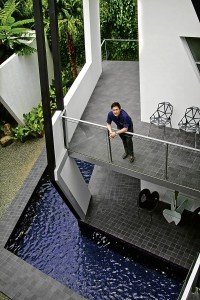
When London-trained Filipino architect Carlo Calma started designing a second home near an old one he shares with his family, his foremost consideration was how to facilitate a “conversation” between the old structure and the new one.
Going for a modern theme was a given, since the old home was modern. The two houses are separate structures in the same compound. But while the older one has brick-lined walls and glass panels, the newer one is a neutral-colored building in white, gray, black and touches of matte silver.
“My original purpose was to build a place for entertaining and a gallery for my sculptures,” says Calma, 30, who does abstract and “bespoke” pieces made mostly of wood and acrylic.
“Since the place has enough space for a couple of bedrooms, including an office, I’m now open to the idea of moving here one day. Anyway, it’s just a few steps away from our old home.”
Carlo comes from the famous architect clan. He is nephew of veteran architect/sculptor Lor Calma and first cousin of Lor’s equally famous architect-son Ed. His dad Pabling, a retired civil engineer, is also a prominent name in construction.
Apart from a play of straight and diagonal lines that draw the visitors’ eyes and prevent the new house from becoming predictable, the structure is noteworthy for its series of glass-lined balconies supported by metal frames.
Functional elements
To avoid monotony and set the house apart from typical Asian modern houses, Calma introduced functional design elements, including a matte stainless steel sliding gate.
To temper the bright morning sun, for instance, he shielded the new structure’s upright front windows with “vertical gardens.” The system, which comes with built-in sprinkler, is imported. Calma tapped a local company to install it.
“I envisioned both houses to have some sort of conversation,” says Calma. “My dad loves the view of the new house from the old one, particularly when he wakes up in the morning.”
Not only does the structure allow the outside in, the balconies also give people in the new building an unimpeded view of the old one.
Color is confined mainly to a number of Calma’s artworks within and outside the house. Another source of color is the cobalt blue-tiled L-shaped swimming pool that lines one side of the house and extends all the way to a part of the living room.
Calma also played with contrasts. After using dark gray Italian tiles in the house’s exterior, he opted for off-white Carrara marble for the ground floor’s public areas; this echoes the color of a Carrara-top dining table with leather-bound chairs by Menotti in the formal dining area.
There’s also a play on hues. A boomerang-shaped upholstered sofa in silver by the famous Zaha Hadid, for instance, is matched with a silver-painted chandelier made from the backrest of old chairs from Pampanga. This is one of his art pieces.
“I call them bespoke pieces,” he says, referring to his artworks, “because if I could have it my way, I’d rather do art pieces that go with particular spaces I designed as an architect.”
Luz, Cobonpue, Forster
Apart from shelves and countertops, other functional and bespoke pieces he did include a round minimalist silver clock which, with the number eight extending to a corner of the wall, doubles as a mini bookshelf. He also designed several faucets in the bathrooms. He loves designing for the bathroom.
His bespoke works, including several purely art pieces, go well with paintings by Arturo Luz and statement chairs by the likes of Kenneth Cobonpue, B&B Italia and Norman Foster.
In lieu of Carrara marble, he opted for teakwood on the second floor, including a third-floor loft. Calma considers the sculptural staircase, which he designed himself using teakwood and matte stainless steel, an “artifact” in itself.
“Whenever I design a house, I make it a point to create a built-in artifact,” he explains. “This time, it’s the staircase. The idea of using stratified lines is again evident. The staircase’s change of morphology can be seen in the straight lines that span out and eventually protrude as one climbs its steps.”
Drawing inspiration from his travels abroad, Calma designed not one but four statement bathrooms. To give each bathroom a bespoke feel, he designed some of the fixtures himself by using either custom-made or hard-to-find faucets, sinks and countertops.
“I always have fun doing bathrooms,” says Calma, despite the obvious expense it entails to achieve his vision. “Whenever I travel abroad, I try to stay in some of the best boutique hotels. It’s one of the first things I check as soon as I enter my room.”
Unlike hotel chains, he says, some of these boutique hotels feature the best and most interesting bathrooms. Apart from introducing quirky details, a good number of these bathrooms have out-of-the box configurations. Calma has worked at achieving the same level of surprise and quirky approach captured in his latest project.